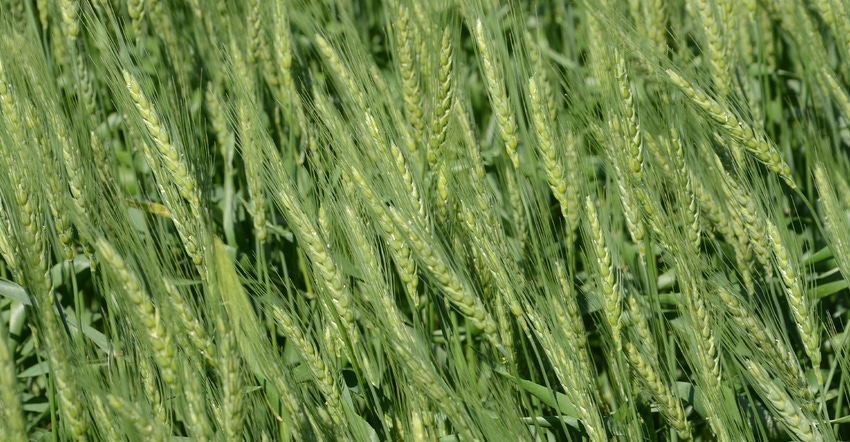October 17, 2019

University crop trials are the bread-and-butter source of information for farmers seeking to improve yield and performance on their farms. In Idaho, wheat growers can turn to Idaho Extension for that information, which conducts trials across the state every season.
In south central and southeast Idaho, Juliet Marshall leads efforts on wheat development and she’s pleased with this year's results. Marshall is a University of Idaho research professor and Extension specialist in plant pathology.
Marshall says some varieties have shown yields over 200 bushels per acre. “Even though it’s small-plot trial results and that’s not necessarily completely reflective of what goes on in a grower’s field, it does show that the genetic potential of some of these varieties is quite capable of hitting that 200-bushel mark,” she says.
Long a champion of the 200-bushel club, Marshall is working to promote best management practices and convincing growers to focus on the profitability of small grains in their rotations. She notes that most farmers focus on sugarbeets and potatoes, over small grains. “We are trying to promote to the growers that, on a yield-per-acre basis, there are varieties that will yield greater than the minimum that they need to break even,” she says. “But it’s not just maximum yield that we’re promoting. We’re promoting sustainable practices and profitability, because it’s the economics that is the most important for our growers.”
Falling number tests associated with all UI Extension variety trials from 2013 to 2018 are available for growers to review. That’s information you can use to better determine which locations and varieties are more susceptible to issues associated with starch quality.
Adds Marshall: “The variety trials, in my opinion, are extremely important for getting good information to the growers on what wheat and barley varieties work best for their areas.”
Northern Idaho trials
Up north, early results for the 2019 trials appear to be average to slightly above average for yields, with one exception. A dry fall in 2018 followed by heavy snows in February and March were a worry for Kurt Schroeder, UI Extension cropping systems agronomist.
“The wheat looked really ratty coming out of winter,” Schroeder says. “There was a lot of unevenness across the fields, but with the cool weather we had throughout May and June, and moderate weather in July and timely rains, it really saved the winter wheat — and yields are better than expected. We had very good test weights this year. The one exception is Bonners Ferry.”
The Bonners Ferry, Idaho, trial saw a significant decrease in yield this year. This likely was due to an infestation of Hessian fly — a pest typically found in spring wheat, not winter wheat.
Schroeder notes that Hessian fly has been in that area of the state for two years; and for 2019, the infestation was severe in winter wheat. “We had an average of 30% lodging in our soft white wheat plots, and that was a direct result of the Hessian fly because the larvae feed at the base of the stems, weakening the straw — which are then prone to lodging.”
A growing fly problem
The life cycle of the Hessian fly is to lay eggs in the spring, and larvae feed on the base of the plant as it is developing. That reduces the plant’s ability to produce seed. Given the life cycle of the pest, breeders have worked to develop several Hessian fly-tolerant varieties for spring wheat. There are few winter wheat varieties developed to address the issue.
Schroeder notes that prior to 2018, Hessian fly hadn’t been a problem in winter wheat. It’s also a growing concern for spring wheat. “It’s risky to not plant a variety with Hessian fly resistance,” he adds.
How severe is the problem? Variety trials in Bonners Ferry usually see yields average 110 bushels per acre. This year, yields were in the range of 30 to 40 bushels per acre. Schroeder adds that in conversations with growers, many shared they had more damage because of the fly. “They are at a loss for what to do about it, because there is almost no tolerance in our winter wheat for Hessian fly,” Schroeder says.
Schroeder alerted Arash Rashed, an entomologist with the UI College of Agricultural and Life Sciences, of the issue. Rashed oversees the Host Plant Resistance program at UI, which screens wheat germplasm from UI and Washington State University (WSU) breeding programs. Rashed suspects climate variability and/or shifts in the pest genotype(s) are contributing factors to the appearance of the pest in winter wheat fields.
“These variables may also explain the first-time appearance of the pest in southern Idaho in 2015,” Rashed says.
Rashed is working to examine the possible reasons for the infestation and, more importantly, identify sources of resistance in Pacific Northwest winter wheat cultivars, with Jianli Chen, who holds the D. Blaine Jacobsen wheat breeding professorship at UI; and Mike Pumphrey, who holds the O.A. Vogel endowed chair of spring wheat breeding and genetics at WSU.
Rashed notes that until resistant winter wheat varieties become available, the strategies that can help reduce Hessian fly infestations are crop rotation, plowing under stubble of harvested spring wheat and management of volunteer plants, and delayed fall planting.
Schroeder will continue his trials at Bonners Ferry and five other sites in northern Idaho, working to provide growers information for informed seed-buying decisions. He notes the aim of the trials is to give “producers an objective view of all these varieties in one location.”
Source: University of Idaho. The source is solely responsible for the information provided and is wholly owned by the source. Informa Business Media and all its subsidiaries are not responsible for any of the content contained in this information asset.
You May Also Like




